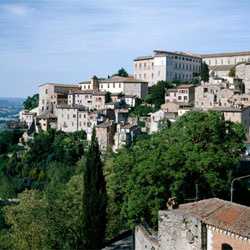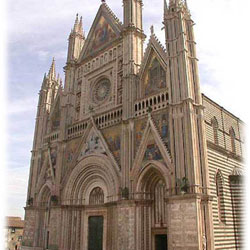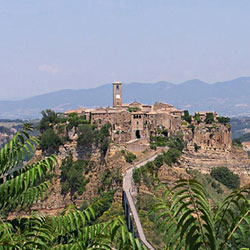Umbria and Marche Tours
Perugia, Deruta, Castiglione del lago | Spoleto, Spello, Bevagna, Assisi | Todi, Orvieto, Civita di Bagnoregio | Gubbio, Urbino
Todi, Orvieto, Civita di Bagnoregio
Suggested day tour from Rome with the visit of Todi, Orvieto and Civita di Bagnoregio, the service is driver/guided and is individually personalized.
Perugia, Deruta, Castiglione del lago | Spoleto, Spello, Bevagna, Assisi | Todi, Orvieto, Civita di Bagnoregio | Gubbio, Urbino
Todi, Orvieto, Civita di Bagnoregio
Suggested day tour from Rome with the visit of Todi, Orvieto and Civita di Bagnoregio, the service is driver/guided and is individually personalized.
| Todi Those visiting Todi will, undoubtedly, want to discover the cultural attractions of the city, birthplace of the poet Jacopone di Todi, famous for his poems in dialect and one of the first in Italy to compose in dialect. Although they may already know of Todi's mythological narratives which tell of its origins, the visitor will most certainly be surprised to discover the beauty of the monuments of the Medieval era and the works of art of the Renaissance period. Amongst these, the Palazzo del Capitano, the Palazzo dei Priori, the Cathedral, the Church of St Fortunato, the city's patron saint and, finally, the Temple della Consolazione which houses numerous works of art. Even if Todi past has been a bloody one, with numerous battles involving pillage and hostility, today Todi is known as a gloriously peaceful city of culture. |
 |
| Orvieto. Whilst few people know that the famous Well of St Patrick was constructed in Orvieto when Pope Clemente VII sought refuge in the city, many more are familiar with the fine wine produced in the surrounding vineyards. But Orvieto is also an architectural treasure trove with a host of fine buildings dating from the 13th to 16th century. In addition to St Patrick's well, constructed to conserve the water of the Rocca dell'Arbornoz, one finds the Cathedral, Palazzo dei Sette, Palazzo del capitano del Popolo, the church of St Giovenale, Palazzo Soliano, the Church of St Andrea, the Church of St Domenico. Orvieto is also home to prestigious museums such as the Museum Opera del Duomo and the Museum of Modern Art. Visitors should be sure to visit the underground city of Orvieto, the Necropoli of the clay Crucifix and the Mancinelli theatre. Not to mention Orvietto's Cathedral, erected to consecrate the miracle of the blood, and where one can admire the Corporale and St Brizio chapels with frescos by Signorelli and Perugino. |
 |
| Civita di Bagnoregio. Civita di Bagnoregio is about 145 km (90 mi) north of Rome. It was founded by Etruscans over twenty-five hundred years ago, has seen its population dwindle to just fifteen residents over the course of the 20th century. Civita was the birth of Saint Bonaventure, born in 1274. The location of his boyhood house has long since fallen off the edge of the cliff. By the 16th century Civita was beginning to decline, becoming eclipsed by its former suburb Bagnoregio. At the end of the 17th century, the bishop and the municipal government was forced to move to Bagnoregio due to a major earthquake, accelerated its decline. At that time the area was part of the Papal States. In the 19th century Civita's location was turning into an island and the pace of the erosion quickened as the layer of clay below the stone was reached in the area where today's bridge is located. Bagnoregio continues as a small but prosperous town, while Civita became known as il paese che muore (in Italian: "the dying town"). Civita has only recently been experiencing a tourist revival. The town is noted for its striking position atop a plateau of friable volcanic tuff overlooking the Tiber river valley, in constant danger of destruction as its edges fall off, leaving the buildings built on the plateau to crumble. As of 2004, there are plans to reinforce the plateau with steel rods to prevent further geological damage. The city is also much admired for its architecture some spanning several thousand years. Civita di Bagnoregio owes much of its unaltered condition to its relative isolation: the town was able to withstand most intrusions of modernity as well as the destruction wrought by two world wars. The town was placed on the world Monuments 2006 Watch List of the 100 most endangered Sites, due to the threats it faces from erosion and unregulated tourism. |
 |